Matching the two sides of the brain¶
Using techniques for graph matching, we can try to uncover a one-to-one correspondence between the nodes of the left side of the brain and the nodes of the right side.
Preliminaries¶
from pkg.utils import set_warnings
import datetime
import time
import matplotlib.pyplot as plt
import numpy as np
import pandas as pd
import seaborn as sns
from graspologic.match import GraphMatch
from graspologic.utils import to_laplacian
from pkg.data import load_maggot_graph
from pkg.io import savefig, get_out_dir
from pkg.match import quadratic_assignment
from pkg.match.qap import _doubly_stochastic
from pkg.plot import set_theme
from src.visualization import adjplot # TODO fix graspologic version and replace here
from pkg.data import load_network_palette
t0 = time.time()
def stashfig(name, **kwargs):
foldername = "matching_illustration"
savefig(name, foldername=foldername, **kwargs)
colors = sns.color_palette("Set1")
# palette = dict(zip(["Left", "Right"], colors))
palette, NETWORK_KEY = load_network_palette()
set_theme()
Load and process data¶
mg = load_maggot_graph()
mg = mg[mg.nodes["paper_clustered_neurons"]]
ll_mg, rr_mg, lr_mg, rl_mg = mg.bisect(paired=True)
ll_adj = ll_mg.sum.adj
rr_adj = rr_mg.sum.adj
nodes = ll_mg.nodes
nodes["_inds"] = range(len(nodes))
sorted_nodes = nodes.sort_values(["simple_group"])
sort_inds = sorted_nodes["_inds"]
ll_adj = ll_adj[np.ix_(sort_inds, sort_inds)]
rr_adj = rr_adj[np.ix_(sort_inds, sort_inds)]
# Match ratio with this went down to like .7
# ll_adj = to_laplacian(ll_adj, form="R-DAD")
# rr_adj = to_laplacian(rr_adj, form="R-DAD")
def plot_adjs(left, right, title=""):
fig, axs = plt.subplots(1, 2, figsize=(15, 7))
adjplot(
left,
plot_type="scattermap",
sizes=(2, 2),
ax=axs[0],
title=r"L $\to$ L",
color=palette["Left"],
)
adjplot(
right,
plot_type="scattermap",
sizes=(2, 2),
ax=axs[1],
title=r"R $\to$ R",
color=palette["Right"],
)
fig.suptitle(title, ha="center", x=0.51)
return fig, axs
plot_adjs(ll_adj, rr_adj, title="Known alignment")
(<Figure size 1080x504 with 2 Axes>,
array([<AxesSubplot:title={'center':'L $\\to$ L'}>,
<AxesSubplot:title={'center':'R $\\to$ R'}>], dtype=object))
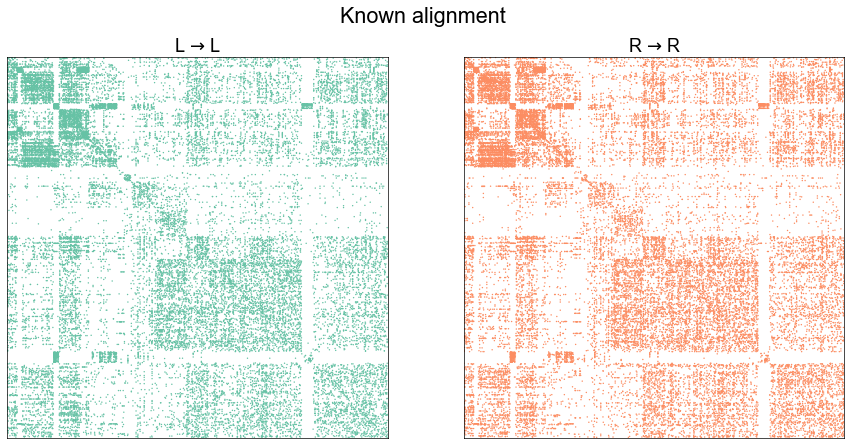
Run several restarts of graph matching to understand the variance in solutions¶
def generate_random_doubly_stochastic(n, alpha=0.5):
J = np.ones((n, n)) / n
K = np.random.uniform(size=(n, n))
# Sinkhorn balancing
K = _doubly_stochastic(K)
P = J * (1 - alpha) + K * alpha
return P
options = dict(maximize=True, maxiter=30, shuffle_input=False, tol=1e-14)
n = len(ll_adj)
n_restarts = 10
alpha = 0
initial_rows = []
best_res = None
best_fun = -np.inf
for i in range(n_restarts):
currtime = time.time()
shuffle_inds = np.random.permutation(n)
unshuffle_inds = np.argsort(shuffle_inds)
P0 = generate_random_doubly_stochastic(n, alpha)
options["P0"] = P0.copy()
res = quadratic_assignment(
ll_adj, rr_adj[shuffle_inds][:, shuffle_inds], options=options
)
res["input_shuffle"] = shuffle_inds
res["P0"] = P0
initial_rows.append(res)
if res["fun"] > best_fun:
best_fun = res["fun"]
best_res = res
match_ratio = (unshuffle_inds == res["col_ind"]).mean()
print(f"{time.time() - currtime:.3f} seconds elapsed for restart {i+1}.")
print(f"Restart {i+1} did {res['nit']} iterations.")
print(f"Final score: {res['fun']}")
print(f"Match ratio: {match_ratio}")
print()
10.431 seconds elapsed for restart 1.
Restart 1 did 30 iterations.
Final score: 826668.0
Match ratio: 0.8018166804293972
10.279 seconds elapsed for restart 2.
Restart 2 did 26 iterations.
Final score: 835306.0
Match ratio: 0.7745664739884393
13.261 seconds elapsed for restart 3.
Restart 3 did 30 iterations.
Final score: 834678.0
Match ratio: 0.791907514450867
13.670 seconds elapsed for restart 4.
Restart 4 did 30 iterations.
Final score: 813866.0
Match ratio: 0.7720891824938068
12.878 seconds elapsed for restart 5.
Restart 5 did 30 iterations.
Final score: 824108.0
Match ratio: 0.7745664739884393
11.989 seconds elapsed for restart 6.
Restart 6 did 28 iterations.
Final score: 822726.0
Match ratio: 0.7861271676300579
11.302 seconds elapsed for restart 7.
Restart 7 did 26 iterations.
Final score: 827739.0
Match ratio: 0.7795210569777044
11.782 seconds elapsed for restart 8.
Restart 8 did 30 iterations.
Final score: 822873.0
Match ratio: 0.7927332782824112
11.304 seconds elapsed for restart 9.
Restart 9 did 30 iterations.
Final score: 830558.0
Match ratio: 0.7803468208092486
11.620 seconds elapsed for restart 10.
Restart 10 did 28 iterations.
Final score: 825977.0
Match ratio: 0.7902559867877786
Illustrate graph matching progress by iteration¶
currtime = time.time()
max_iter = res["nit"]
options = dict(maximize=True, maxiter=1, shuffle_input=False, tol=1e-4)
n = len(ll_adj)
max_iter = 30
shuffle_inds = best_res["input_shuffle"]
P = best_res["P0"]
unshuffle_inds = np.argsort(shuffle_inds)
plot_adjs(ll_adj, rr_adj[shuffle_inds][:, shuffle_inds])
rows = []
fun = 0
for i in range(max_iter):
options["P0"] = P
rr_adj_shuffle = rr_adj[shuffle_inds][:, shuffle_inds]
res = quadratic_assignment(ll_adj, rr_adj_shuffle, options=options)
P = res["P_final"]
res["iteration"] = i
perm_inds = res["col_ind"]
match_ratio = (perm_inds == unshuffle_inds).mean()
res["match_ratio"] = match_ratio
plot_adjs(ll_adj, rr_adj_shuffle[perm_inds][:, perm_inds], title=f"Iteration {i}")
rows.append(res)
if res["fun"] == fun:
break
fun = res["fun"]
print(f"{time.time() - currtime:.3f} seconds elapsed.")
results = pd.DataFrame(rows)
fig, axs = plt.subplots(2, 1, figsize=(8, 8))
sns.lineplot(data=results, x="iteration", y="fun", ax=axs[0])
sns.lineplot(data=results, x="iteration", y="match_ratio", ax=axs[1])
12.034 seconds elapsed.
<AxesSubplot:xlabel='iteration', ylabel='match_ratio'>
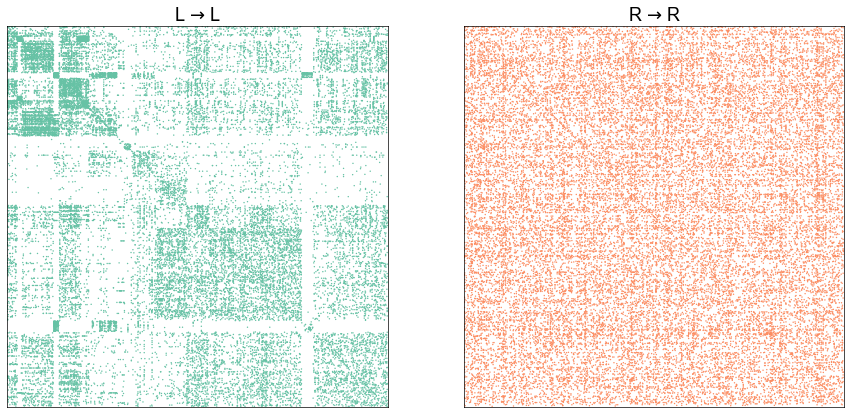
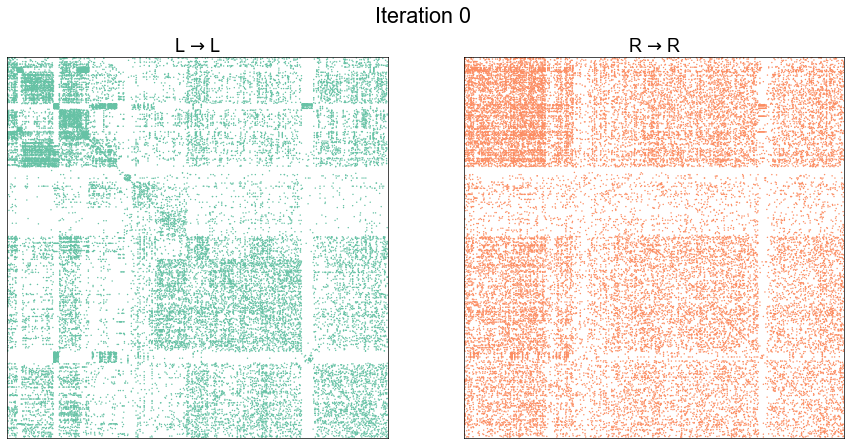
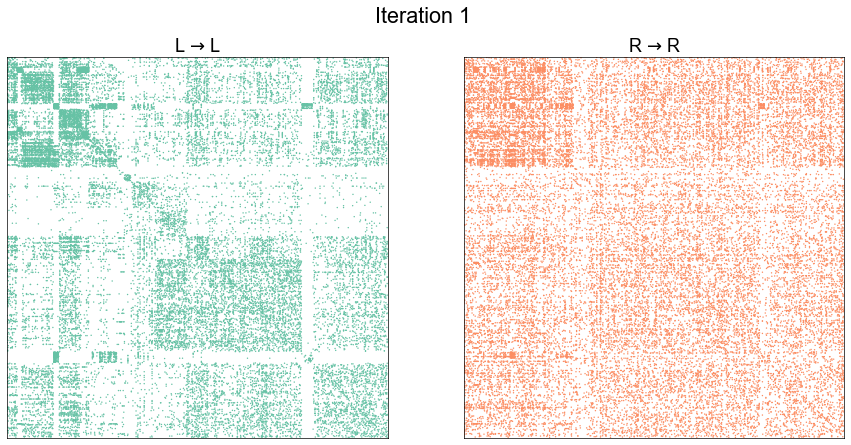
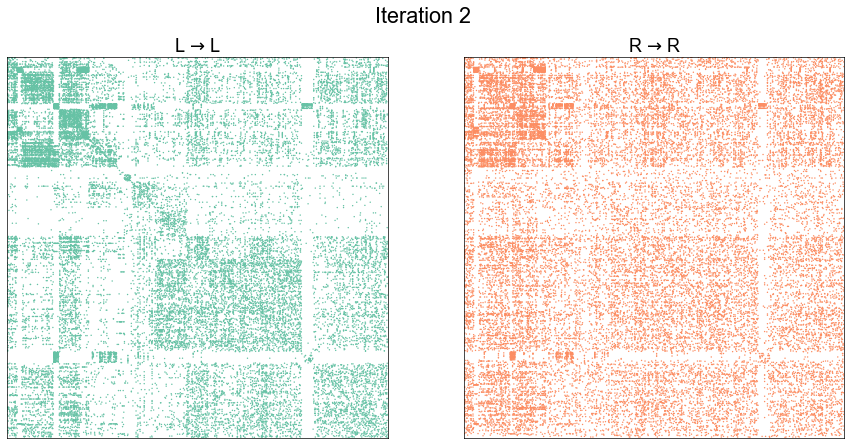
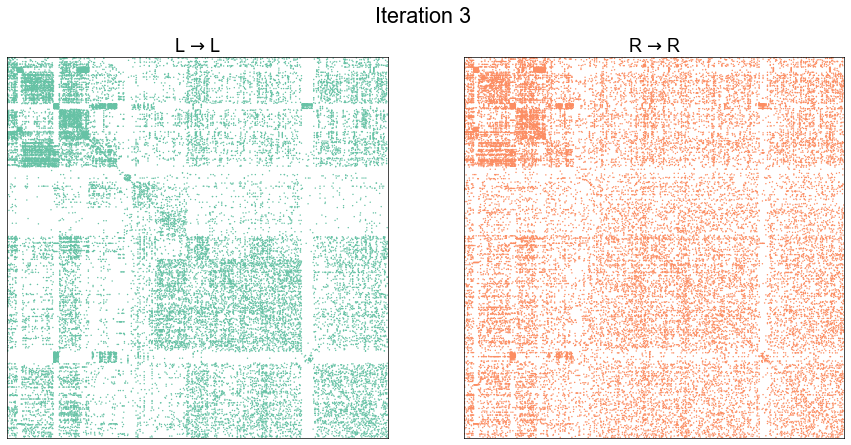
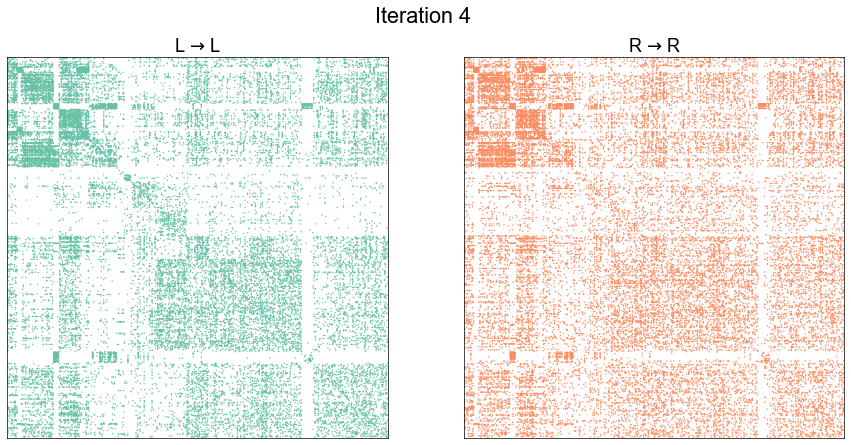
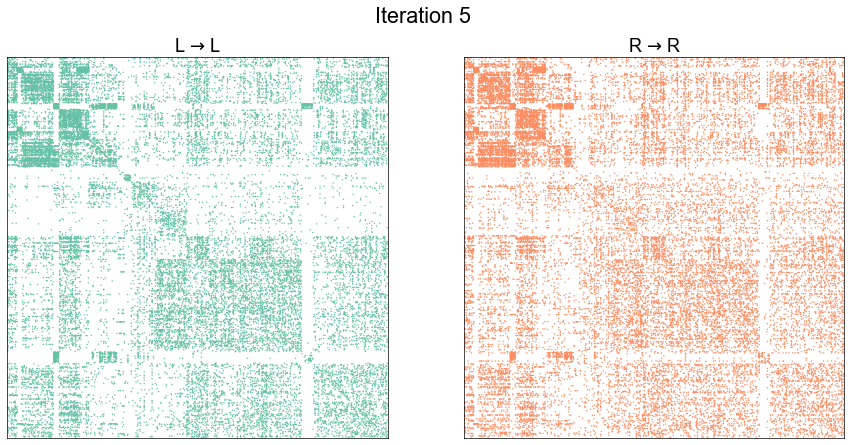
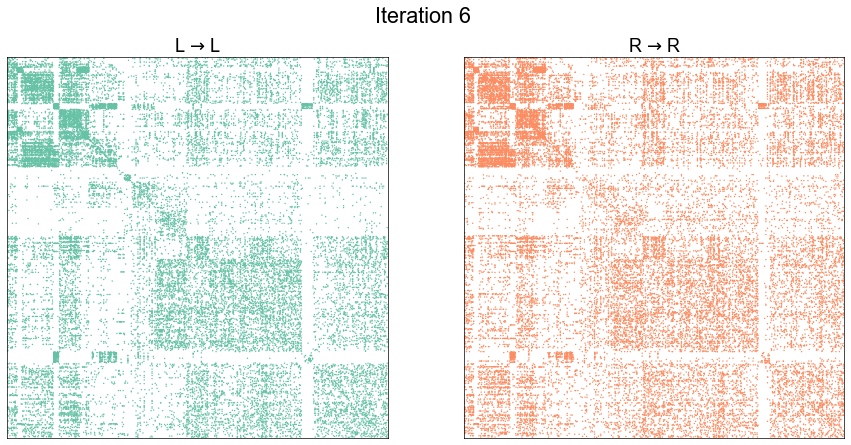


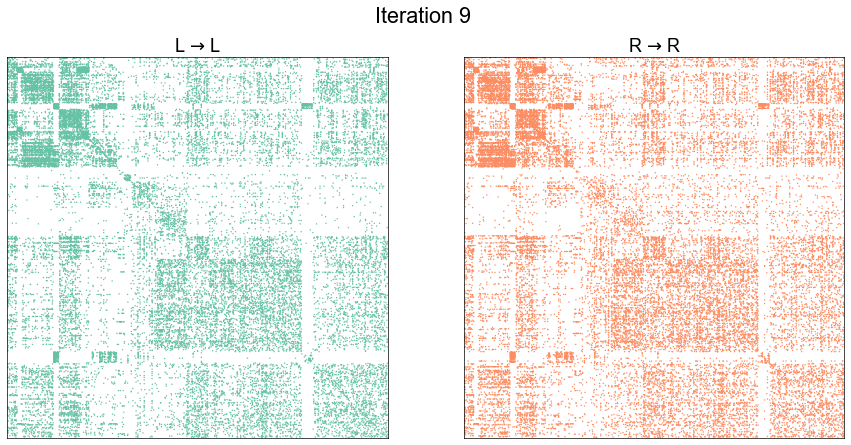
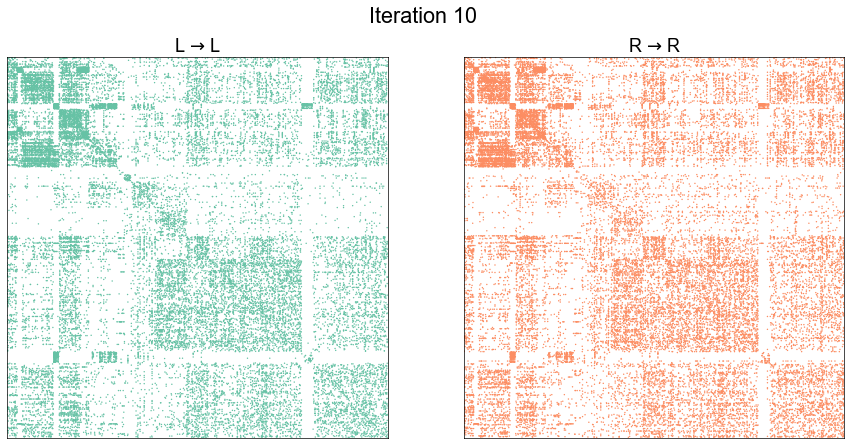


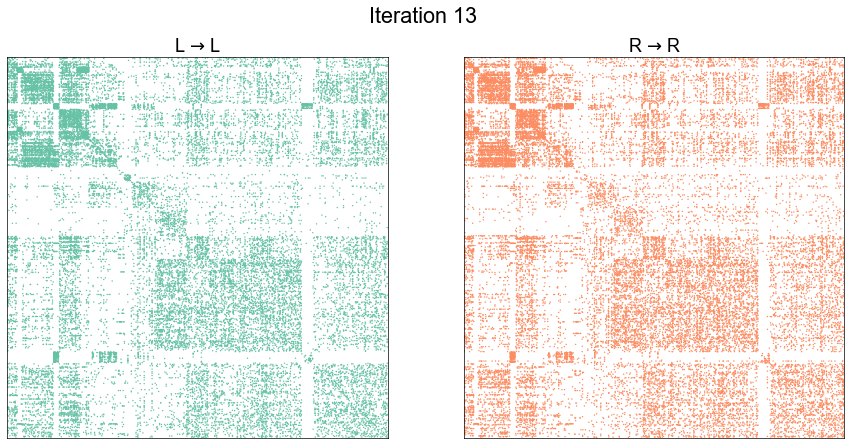

Start graph matching from the known pairs to see if we can improve¶
gm = GraphMatch(n_init=25, init=np.eye(n), max_iter=100, shuffle_input=True, eps=1e-4)
gm.fit(ll_adj, rr_adj)
perm_inds = gm.perm_inds_
match_ratio = (perm_inds == np.arange(n)).mean()
print("Match ratio when initializing from known pairs:")
print(match_ratio)
print("GMP objective function after initializing from known pairs:")
print(gm.score_)
print("GMP objective function from known pairs:")
print((ll_adj * rr_adj).sum())
Match ratio when initializing from known pairs:
0.8860445912469034
GMP objective function after initializing from known pairs:
868447.0
GMP objective function from known pairs:
865969.0
End¶
elapsed = time.time() - t0
delta = datetime.timedelta(seconds=elapsed)
print("----")
print(f"Script took {delta}")
print(f"Completed at {datetime.datetime.now()}")
print("----")
----
Script took 0:15:31.255236
Completed at 2021-05-13 14:58:07.099221
----
